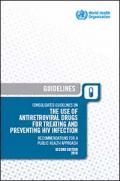Guidelines - Released in 2016
These guidelines provide guidance on the diagnosis of human immunodeficiency virus (HIV) infection, the use of antiretroviral (ARV) drugs for treating and preventing HIV infection and the care of people living with HIV. They are structured along the continuum of HIV testing, prevention, treatment and care.
Implementing all the recommendations in these guidelines at the national and global levels will have important implications for programme priority-setting, funding and service delivery. As in 2013, operational guidance is included to help countries as they work to implement new approaches and strengthen the treatment cascade. These guidelines include 10 new recommendations to improve the quality and efficiency of services to people living with HIV. Implementation of the recommendation on universal eligibility for ART will mean that more people will start ART earlier. Importantly, in this guidance WHO emphasizes the need for differentiated approaches to care for people who are stable on ART, such as reducing the frequency of clinic visits and community ART distribution. Such efficiencies are essential if countries with a high burden of HIV infection are to manage their growing numbers of people receiving ART and reduce the burden on people receiving treatment and health facilities.
Downloads
Organizations
- World Health Organization (WHO)






